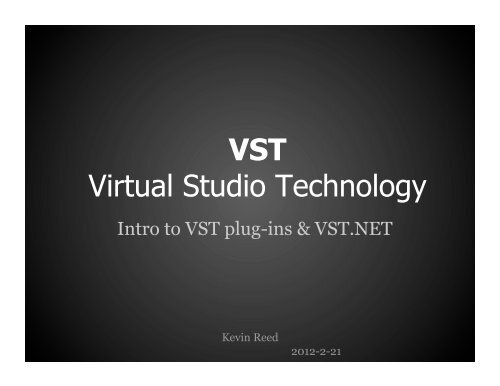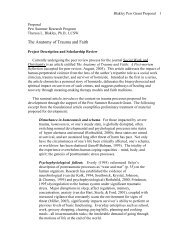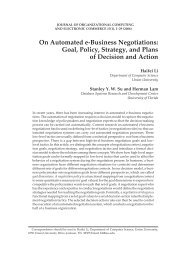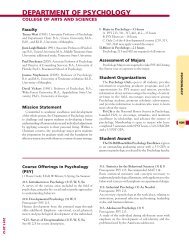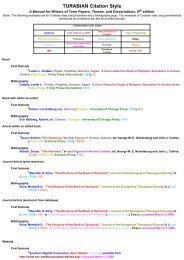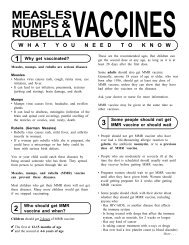VST Virtual Studio Technology
VST Virtual Studio Technology
VST Virtual Studio Technology
Create successful ePaper yourself
Turn your PDF publications into a flip-book with our unique Google optimized e-Paper software.
<strong>VST</strong><br />
<strong>Virtual</strong> <strong>Studio</strong> <strong>Technology</strong><br />
Intro to <strong>VST</strong> plug-ins & <strong>VST</strong>.NET<br />
Kevin Reed<br />
2012-2-21
What is <strong>VST</strong><br />
• an interface to<br />
integrate<br />
Audio Synthesizers Audio Effect Plugins<br />
DAW (Digital Audio Workstation)
History • 1996<br />
o SDK released by Steinberg in 1996<br />
o released with Cubase 3.02<br />
o included some basic effect plug-ins<br />
• 1999<br />
o included updates for <strong>VST</strong>i (virtual instruments)<br />
o Neon - the first <strong>VST</strong>i - 16-voice, 2-oscillator virtual<br />
analog synthesizer
Steinberg <strong>VST</strong> SDK<br />
• "Splitting up an effect into these two parts requires some<br />
extra efforts for an implementation of course." [1]<br />
Vst::IComponent<br />
Vst::IAudioProcessor<br />
Processor<br />
<strong>VST</strong>3 Audio Effect<br />
Vst::EditController<br />
Edit Controller<br />
"But this separation<br />
enables the host to run<br />
each component in a<br />
different context. It can<br />
even run them on<br />
different<br />
computers." [1]
Stienberg::IAudioProcessor<br />
• [1]<br />
1. Setup (configuration must happen before<br />
processing)<br />
a. Process Setup (parameters that cannot be changed<br />
during processing)<br />
Stienberg::Vst::ProcessSetup<br />
b. Dynamic Speaker Arrangements<br />
Stienberg::Vst::IAudioProcessor::setBusArrangements<br />
2. Process (implements actual processing)<br />
Stienberg::Vst:IAudioProcessor::process<br />
a. Block Size (processing done in blocks)<br />
b. Audio Buffers<br />
c. Parameters & Automation
<strong>VST</strong>.NET<br />
• "<strong>VST</strong>.NET does nothing with the C++ SDK classes that<br />
Steinberg provides. It interfaces at the lowest level with<br />
the C function pointers and opcodes and translates those<br />
to and from managed code (C# in this case)." [3]<br />
• Why <strong>VST</strong>.NET [2]<br />
• <strong>VST</strong>.NET is easier to learn than the native SDK API<br />
• You can program <strong>VST</strong> plug-ins in any .NET language<br />
• <strong>VST</strong>.NET provides a framework that simplifies and<br />
clarifies the <strong>VST</strong> interfacing options<br />
• It takes far less time to develop a managed <strong>VST</strong>.NET<br />
plug-in than to develop a C/C++ native <strong>VST</strong> plug-in<br />
• Good documentation<br />
• Existing native <strong>VST</strong> knowledge applies
Implementing an Audio Processor<br />
• using Jacobi.Vst.Core;<br />
using Jacobi.Vst.Framework;<br />
class AudioProcessor : IVstPluginAudioProcessor<br />
{<br />
public int BlockSize { get; set; }<br />
public int InputCount {<br />
get { return 2; }<br />
}<br />
public int OutputCount {<br />
get { return 2; }<br />
}<br />
public double SampleRate { get; set;}<br />
public int TailSize {<br />
get { return 0; }<br />
}
Audio Processor (cont.)<br />
• public void Process(VstAudioBuffer[] inputs, VstAudioBuffer[] outputs)<br />
{<br />
VstAudioBuffer input = inputs[0];<br />
VstAudioBuffer output = outputs[0]; for (int index = 0; index <<br />
output.SampleCount; index++)<br />
{<br />
output[index] = input[index];<br />
}<br />
input = inputs[1];<br />
output = outputs[1];<br />
}<br />
for (int index = 0; index < output.SampleCount; index++)<br />
{<br />
output[index] = input[index];<br />
}<br />
public bool SetPanLaw(VstPanLaw type, float gain)<br />
{<br />
return false;<br />
}<br />
}<br />
#endregion
Changing the Interface Manager<br />
• using Jacobi.Vst.Core;<br />
using Jacobi.Vst.Framework;<br />
using Jacobi.Vst.Framework.Plugin;<br />
class MyPlugin : VstPluginWithInterfaceManagerBase<br />
{<br />
public MyPlugin()<br />
: base("My Plugin",<br />
new VstProductInfo("My Product", "My Vendor", 1000),<br />
VstPluginCategory.Synth,<br />
VstPluginCapabilities.NoSoundInStop,<br />
0,<br />
0) // enter unique plugin ID<br />
{}<br />
protected override IVstPluginAudioProcessor CreateAudioProcessor<br />
(IVstPluginAudioProcessor instance)<br />
{<br />
if (instance == null) return new AudioProcessor(this);<br />
}<br />
// base class just returns 'instance'<br />
return base.CreateAudioProcessor(instance);<br />
}<br />
// other methods...
References<br />
• [1] - Stienberg <strong>VST</strong> SDK 3.5 Documentation<br />
• http://www.steinberg.net/en/company/developer.html<br />
• [2] - <strong>VST</strong>.NET Documentation<br />
• http://vstnet.codeplex.com/releases/view/<br />
58390#DownloadId=192723<br />
• [3] - Mark's Blog Cabin<br />
• http://obiwanjacobi.blogspot.com/2008/05/vstnet.html


